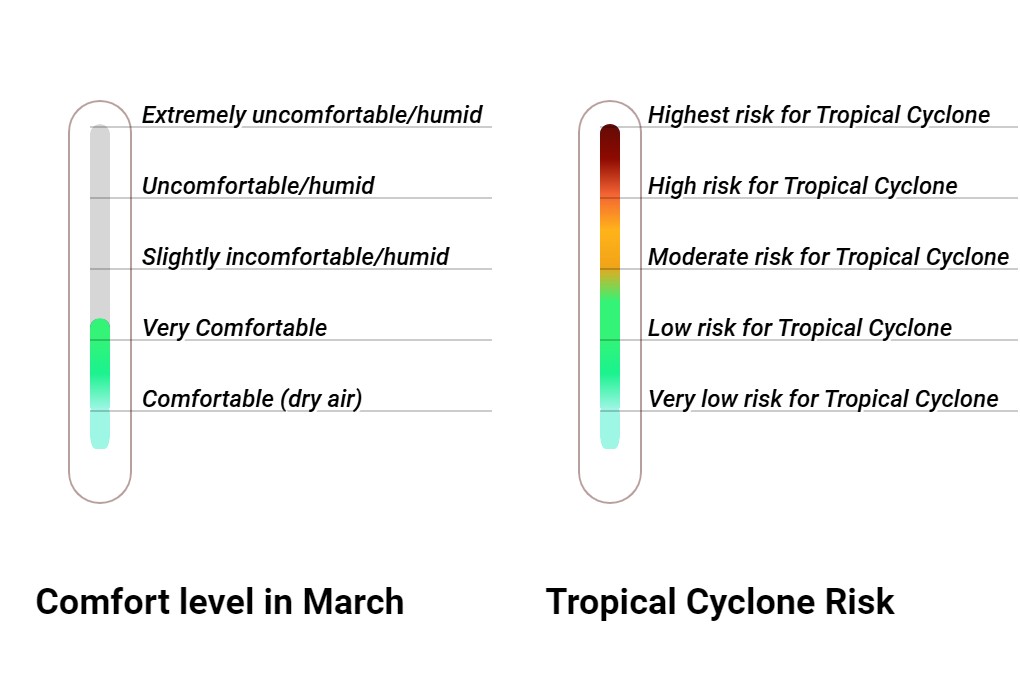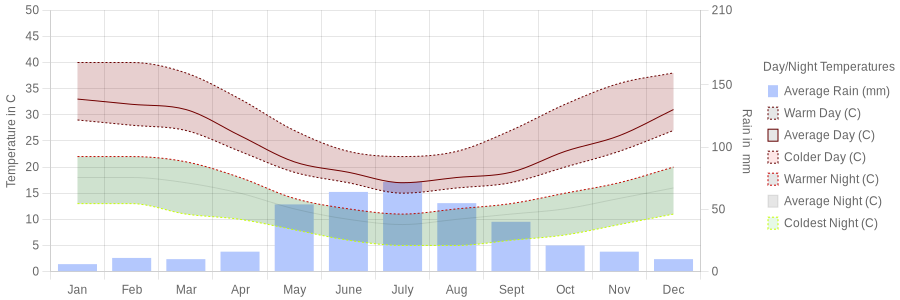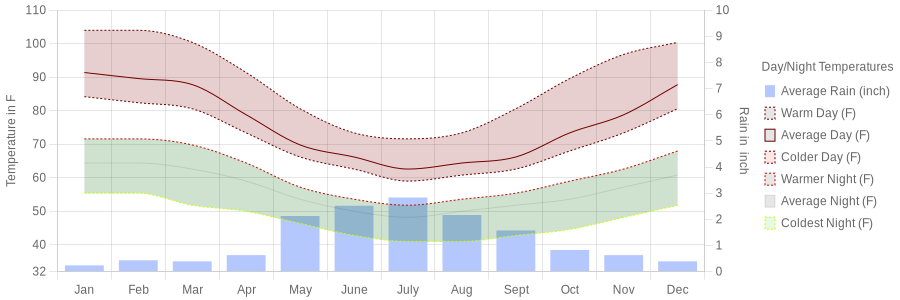March Weather in Australia - 2025
Australia is a beautiful country cum continent. It is the 6th largest country in the world and the largest country in Oceania. The commonwealth of Australia is made up of mainland Australia and a few other smaller islands including Tasmania. Sydney is probably the most popular city in Australia and it is often mistaken as the country's capital however, its capital is actually Canberra. Originally inhabited by indigenous Aboriginal Australians, Dutch and British explorers settled in the country during the 17th century.
Australia has a rich terrain and it is the driest, oldest, and flattest inhabited area on earth. It has a diverse landscape including rainforests, deserts, and mountain ranges. Fondly known as 'the land down under' or 'down under', Australia is located in the southern hemisphere of the planet between the Indian and the Pacific Ocean. Some of the oldest human remains were found in Australia, these remains were ancestors of the Aboriginal culture which is among the oldest continual civilizations.
Generally, March in Australia will be really nice, with an average temperature of around 86°F / 30°C. But due to the very dry air, it can feel somewhat uncomfortable for some people. You can expect around 3 rainy days, with on average 0.4 inches / 9 mm of rain during the month of March.

Contents
- 1 March weather in Australia
- 2 March weather in Australia in more detail
- 3 What to do in Australia in March
- 4 Is it humid in Australia in March?
- 5 Is March a good time to go to Australia?
- 6 Does it rain all day in Australia in March?
- 7 Is March the rainiest month in Australia?
- 8 Is March the most sunniest month in Australia?
- 9 More information about Australia
- 10 Weather in Australia in other months
- 11 What to do in Australia for each month
March weather in Australia
To get a good overview of the type of weather you can expect in March in Australia, we will look at the day and night temperature, minimum and maximum water temperature, and if March is comfortable or humidGenerally, March in Australia will be really nice. Historical data shows that you can expect an average temperature of around 86°F / 30°C. But due to the very dry air, it can feel somewhat uncomfortable for some people. During the night, it will cool down to around 62°F / 17°C.
Australia does not have a lot of rainy days in March. You can expect around 3 rainy days, with on average 0.4 inches / 9 mm of rain during the whole month.



March weather in Australia in more detail
To get a better feeling for the type of weather, you can expect in March in Australia, we will look at the temperature, rain, wind, humidity, water temperature, and sun and clouds- What will the temperature be in Australia in March
Generally, you can expect in March an average temperature of 86°F / 30°C during the day and an average of 62°F / 17°C during the night. In March, during the warmest part of the afternoon, the temperature can often get as high as 100°F / 38°C, and at the end of the night, it can get as low as 51°F / 11°C.
When looking at the whole year, July is the coldest month, with an average temperature of around 62°F / 17°C. January and February are the hottest months, with an average temperature of around 89°F / 32°C. When comparing March with the temperature in the month before and after, this is almost equal to February, which sees an average maximum temperature of around 89°F / 32°C. And slightly more than April, which sees an average maximum temperature of around 77°F / 25°C.
But average temperatures only tell half of the story. It is also good to check the maximum and minimum temperatures. When looking at the whole year, January and February are the hottest months, with a temperature of around 104°F / 40°C. July is the coldest month, with a temperature of around 71°F / 22°C. When comparing March with the temperature in the month before and after, this is almost equal to February, which sees an average maximum temperature of around 104°F / 40°C. And slightly more than April, which sees an average maximum temperature of around 91°F / 33°C.
In the following graph, you can see how many cold and hot days you can expect in Australia each month:
- Can you expect rain in March in Australia?
Generally, you can expect about 3 rain days in March, with on average 0.4 inches / 9 mm of rain.
When looking at the whole year, December is the dryest month, with an average rainfall of around 0.2 inches / 5 mmmm. July is the wettest month, with an average rainfall of around 2.7 inches / 69 mmmm. When comparing March with the month before and after, this is almost equal to February, which sees around 0.4 inches / 10 mm of rain. And less than April, which sees around 0.6 inches / 15 mm of rain
If we look at the number of days with rain, January and February And are the months with the least amount of rain days with an average of between 2 and 3 days July is the month with the most rain days with an average of between 10 and 11 days. When comparing March with the month before and after, this is almost equal to February, which sees an average of between 2 and 3 days of rain. And almost equal to April, which sees around 4 days of rain
- What will the water temperature be in Australia for March
You can expect in March, the water temperature for Australia to be between 64°F / 18°C and 60°F / 16°C.
To compare the water temperature we will use the maximum water temperature. You can expect this temperature on a more sunny day, close to the shore, when the wind does not mix the relatively warmer and colder water.
January has the highest water temperature, with an average of between 64°F / 18°C and 66°F / 19°C. September has the lowest water temperature, with an average of between 55°F / 13°C and 57°F / 14°C. When comparing the water temperature from March with the month before and after, March has a water temperature almost equal to February, with a water temperature of around 64°F / 18°C. And almost equal to the water temperature from April, that is around 62°F / 17°C.
- Can you expect in March a lot of sunny days in Australia
Generally, you can expect around 19 sunny days in March and around 10 partly sunny days. The remaining days will be cloudy.
When looking at the whole year, January and March And are the months with the higest number of sunny days, with around 19 sunny days. July is the month with the lowest number of sunny days, with an average of between 10 and 11 sunny days. When comparing March with the number of sunny days in the month before and after, it is almost equal to February, with an average of between 17 and 18 sunny days. And slightly more than April, with around 15 sunny days
We have looked at the sunny days in Australia. Let's also look at the cloudy or overcast days. July is the month with the highest number of cloudy days, with an average of between 9 and 10 cloudy days. December is the month with the lowest number of cloudy days, with around 1 cloudy day. When comparing March with the number of cloudy days in the month before and after, it is almost equal to February, with an average of between 1 and 2 cloudy days. And almost equal to April, with around 4 cloudy days
- Will it be comfortable in March in Australia?
Generally, March in Australia will have very dry air, and can feel somewhat uncomfortable for some people. But will be fine for most..
We use the humidity and temperature in Australia to calculate the Wintersun Expert Comfort level for each month. The lower the Wintersun Expert Comfort level, the more comfortable it will be. Only for certain people, extremely dry air can feel slightly uncomfortable.
When looking at the whole year, July has the lowest humidity, with a Wintersun Expert comfort level of "comfortable" (very dry air). January has the highest humidity, with a Wintersun Expert comfort level of "comfortable" (very dry air). When comparing March with the month before and after, this is almost equal to February, which has a Wintersun Comfort level of "comfortable" (very dry air). And almost equal to April, which has a Wintersun Comfort level of "comfortable" (very dry air)
What to do in Australia in March
- Cable beach -this stunning white sanded beach is located in Western Australia. Snowbirds can go on camel rides or enjoy beautiful sunsets while lounging on the beach.
- Purnululu national park - this park is host to some of Australia's top attractions like the Bungle Bungle range. Striped sandstones in orange and black that look like beehives and a naturally occurring amphitheater called Cathedral Gorge.
- The three sisters - this 914 meter (2999 feet) rock formations towers above the Jamison Valley in the Blue Mountain National Park. You can enjoy beautiful views of these rocks from the steepest passenger railway in the world, the Katoomba scenic railway.
- Uluru/Ayers Rock - at over 340 meter (1116 feet) tall, Ayers Rock is one of the largest monoliths in the world. It's also a sacred ground for the aboriginal tribe Anangu and is peculiar for changing hues at sunset into blue, red, and violet from its usual terracotta color.
- Sydney opera house - one of the most recognizable buildings in the world today and a 20th-century architectural masterpiece, this iconic building was created to resemble the sails on a huge ship.
- The great barrier reef - the world's largest barrier system is located in the coral sea and is a top destination for marine life enthusiasts. You can also explore the 2900 coral reefs on a boat cruise.
Is it humid in Australia in March?
A lot of people ask interested in the humidity or relative humidity for Australia in March. But the real question they want to ask is not about humidity but the amount of moisture in the air. Or better, about comfort. Will it be comfortable in March in Australia, or will high humidity make it uncomfortable.To answer this question, we have to look at the dew point. Relative humidity can change a lot in Australia during the day and night, as it changes when the amount of moisture changes and, but also when the temperature changes. It is a lot less reliable for comfort. Where the dew point only varies with the amount of moisture in the air.
Looking at the dew point, we can see that for the month of March, you can expect that Australia will have very dry air, and can feel somewhat uncomfortable for some people. But will be fine for most..
July is the month with the most comfort. It will have very dry air, and can feel somewhat uncomfortable for some people. But will be fine for most.. January is the most uncomfortable month. It will have dry air, and will feel very comfortable. In the graph, you can see that there is some difference between the most comfortable and most uncomfortable months
Is March a good time to go to Australia?
Trying to answer the question of whether March is a good time to go to Australia is not as easy as it first seems. Some people like colder weather, and others prefer a warmer climate. Some are fine with some humidity, and others are not. If your location has air conditioning, the night temperature is less important.
These are some examples. I will try to answer the question with a more generic person in mind. The more detailed information in this article should be enough to check further if this applies to you as well.
If we look at the average temperature for Australia in March, we can see that it will be too hot for a lot of visitors. In March, you can expect it to be really nice, with an average temperature of around 86°F / 30°C. But due to the very dry air, it can feel somewhat uncomfortable for some people. During the night, it will be around 62°F / 17°C.
As the number of overcast days is not high, you can enjoy the sun with around 19 sunny days and 10 partly sunny days.
The last aspect we will look at is rain. You can expect around 3 rainy days, with on average 0.4 inches / 9 mm of rain during March. If it were more than five days, the location would be slightly less attractive for a shorter stay.
We have looked at the average day temperature, the night temperature, humidity, the number of overcast days, and the rain. We think that March in Australia is not the most optimal destination. But that doesn't mean it is not a good time for you to go. As said before, each visitor has their own preferences when it comes to the weather.
Does it rain all day in Australia in March?
In Australia, it does not rain all day in March. You can expect around 3 rainy days, with on average 0.4 inches / 9 mm of rain during the month.
Another way of looking at the rain is the number of sunny days. For Australia, there are, on average 19 sunny days and 10 partly sunny days in March. That clearly shows that it is not raining all the time.
Is March the rainiest month in Australia?
March is not the month with the most rainy days, and not the month with the most rain.
To answer what the rainiest month is in Australia, we will both look at the month with the most rain, and the month with the highest number of rainy days.
July is the month with the the highest number of rainiest days. On average, you can expect 11 days with rain. January and February are the months with the lowest number of rainy days, with aproximately 2 days.
July is the month with the most rain. This is not equal as the one with the most rainy days. On average, you can expect 2.7 inches / 69 mm of rain. January and February are the months with the least amount of rain. This is not the same month as the one with the lowest number of rainy days. You can expect approximately 0.2 inches / 5 mm of rain.
Is March the most sunniest month in Australia?
March is the month with the most sunny days, not the month with the most partly sunny days, and it is not the month with the lowest number of overcast days.
To answer what the sunniest month is in Australia, we will of course look at the month with the most sunniest days, but also look at the month with the biggest number of days that are sunny or partly sunny.
January and March are the months with the highest number of sunny days. On average, you can expect 19 sunny days, and 10 partly suny days. July is the month with the lowest number of sunny days.
December is the month with the highest number of sunny days and partly sunny days combined. While July is the month with the lowest number of sunny days and partly sunny days combined.
The last thing we will look at is the number of overcast days. December is the month with the lowest number of overcast days. While July is the month with the highest number of overcast days.
More information about Australia
Weather in Australia in other months
- Weather in Australia for January
- Weather in Australia for February
- Weather in Australia for April
- Weather in Australia for May
- Weather in Australia for June
- Weather in Australia for July
- Weather in Australia for August
- Weather in Australia for September
- Weather in Australia for October
- Weather in Australia for November
- Weather in Australia for December
What to do in Australia for each month
- What to do in January in Australia
- What to do in February in Australia
- What to do in March in Australia
- What to do in April in Australia
- What to do in May in Australia
- What to do in June in Australia
- What to do in July in Australia
- What to do in August in Australia
- What to do in September in Australia
- What to do in October in Australia
- What to do in November in Australia
- What to do in December in Australia
















